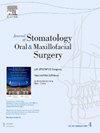不同时间的张口练习对口腔癌术后放疗患者三叉神经痛的影响
IF 1.8
3区 医学
Q2 DENTISTRY, ORAL SURGERY & MEDICINE
Journal of Stomatology Oral and Maxillofacial Surgery
Pub Date : 2024-10-02
DOI:10.1016/j.jormas.2024.102104
引用次数: 0
摘要
目的比较两种不同时间开始的张口运动对口腔癌术后放疗患者咀嚼功能障碍的影响:通过前瞻性随机对照试验,采用目的性抽样,选择 2023 年 3 月至 2024 年 1 月在上海交通大学医学院附属第九人民医院口腔颌面外科接受口腔癌术后放疗的 76 例患者。采用随机数字表法将患者按 1:1 的比例随机分为实验组(38 人)和对照组(38 人)。实验组在术后第二周(放疗前)开始进行张口练习,对照组在术后第四周(放疗开始时)开始进行张口练习。主要结果指标为最大颌间距离(MIO)。次要结果指标包括疼痛视觉模拟量表(VAS)评分和生活质量评分(UW-QOL),分别在基线、术后第二周(放疗前)、术后第四周(放疗开始时)、术后第九周(放疗结束时)和术后第十二周(放疗结束后三周)进行评估:共有 72 名患者完成了所有评估,每组 36 人,样本总体流失率为 5.26%(低于 15%)。两组患者的一般人口统计学特征和临床特征无明显差异。重复测量方差分析显示,各组之间在 MIO、VAS 和 UW-QOL 评分方面存在显著差异,随着时间的推移也存在显著差异,组间时间交互作用也存在显著差异(PC 结论:在口腔癌术后第二周(放疗前)开始进行张口练习可明显改善口腔癌术后放疗患者的张口情况,减轻疼痛,提高生活质量。这为临床实践提供了重要的证据,尽管还需要进一步的研究来验证其长期效果。本文章由计算机程序翻译,如有差异,请以英文原文为准。
The impact of different timing of mouth opening exercises on trismus in postoperative radiotherapy patients with oral cancer
Objective
To compare the effects of starting mouth opening exercises at two different times on trismus in postoperative radiotherapy patients with oral cancer.
Methods
Through a prospective randomized controlled trial, purposive sampling was used to select 76 patients undergoing postoperative radiotherapy for oral cancer from March 2023 to January 2024 at the Department of Oral and Maxillofacial Surgery, Shanghai Ninth People's Hospital, Shanghai Jiao Tong University School of Medicine. Patients were randomly divided into an experimental group (n = 38) and a control group (n = 38) using a random number table at a ratio of 1:1. The experimental group began mouth opening exercises in the second week after surgery (before radiotherapy), while the control group began in the fourth week after surgery (at the start of radiotherapy). The primary outcome measure was maximum interincisal opening (MIO). Secondary outcome measures included pain visual analog scale (VAS) scores and quality of life scores (UW-QOL), assessed at baseline, the second week post-surgery (before radiotherapy), the fourth week post-surgery (at the start of radiotherapy), the ninth week post-surgery (end of radiotherapy), and the twelfth week post-surgery (three weeks after the end of radiotherapy).
Results
A total of 72 patients completed all assessments, with 36 in each group, resulting in an overall sample attrition rate of 5.26 % (less than 15 %). There were no statistically significant differences in general demographic and clinical characteristics between the two groups. Repeated measures ANOVA showed significant differences in MIO, VAS, and UW-QOL scores between groups, over time, and in group-time interactions (P < 0.001). From the fourth week post-surgery (at the start of radiotherapy), the experimental group had significantly higher MIO (P < 0.001), significantly lower VAS scores (P < 0.001), and significantly higher UW-QOL scores (P < 0.001) compared to the control group. These differences persisted at subsequent assessment points.
Conclusion
Initiating mouth opening exercises in the second week post-surgery (before radiotherapy) can significantly improve mouth opening, reduce pain, and enhance the quality of life in postoperative radiotherapy patients with oral cancer. This provides important evidence for clinical practice, although further research is needed to verify the long-term effects.
求助全文
通过发布文献求助,成功后即可免费获取论文全文。
去求助
来源期刊

Journal of Stomatology Oral and Maxillofacial Surgery
Surgery, Dentistry, Oral Surgery and Medicine, Otorhinolaryngology and Facial Plastic Surgery
CiteScore
2.30
自引率
9.10%
发文量
0
审稿时长
23 days
 求助内容:
求助内容: 应助结果提醒方式:
应助结果提醒方式:


